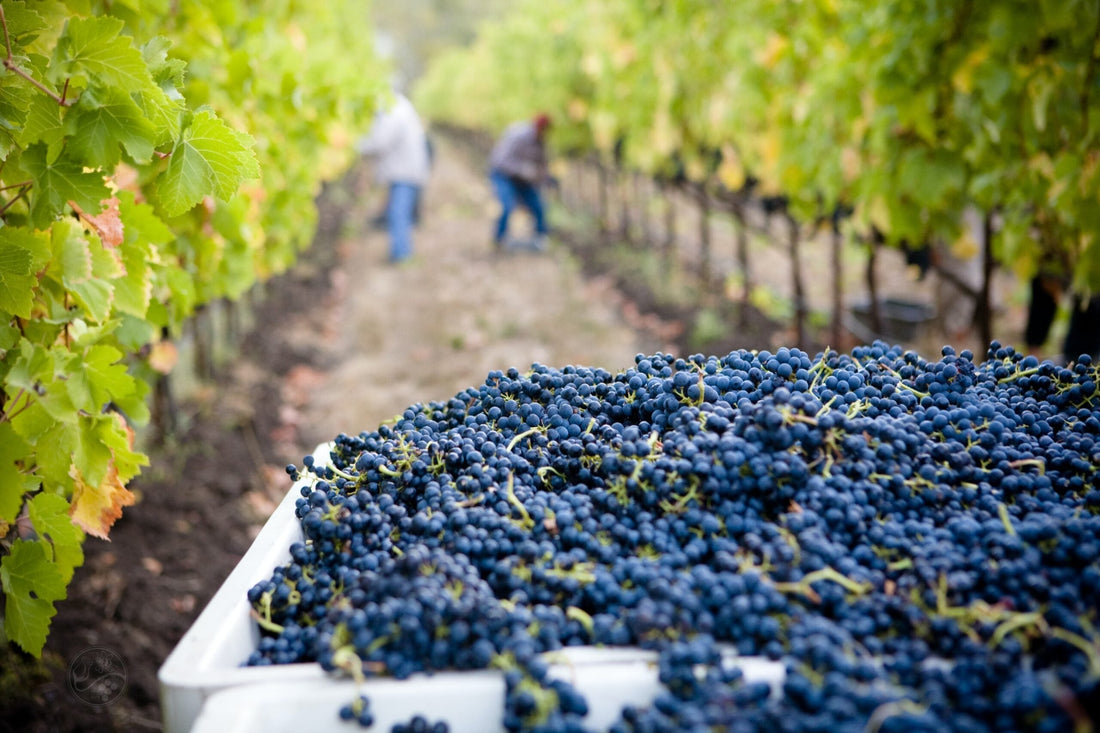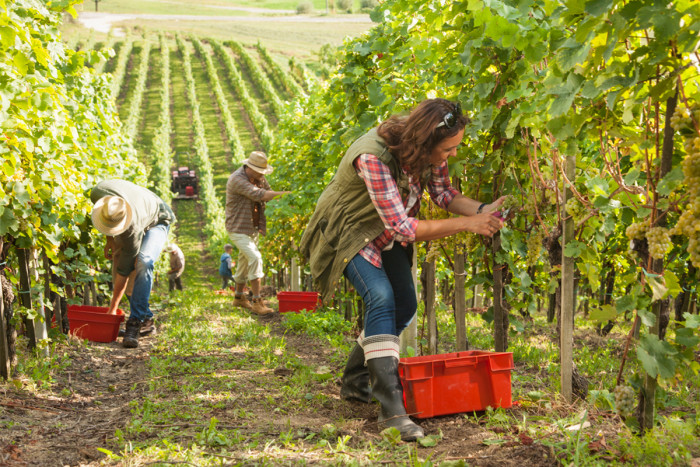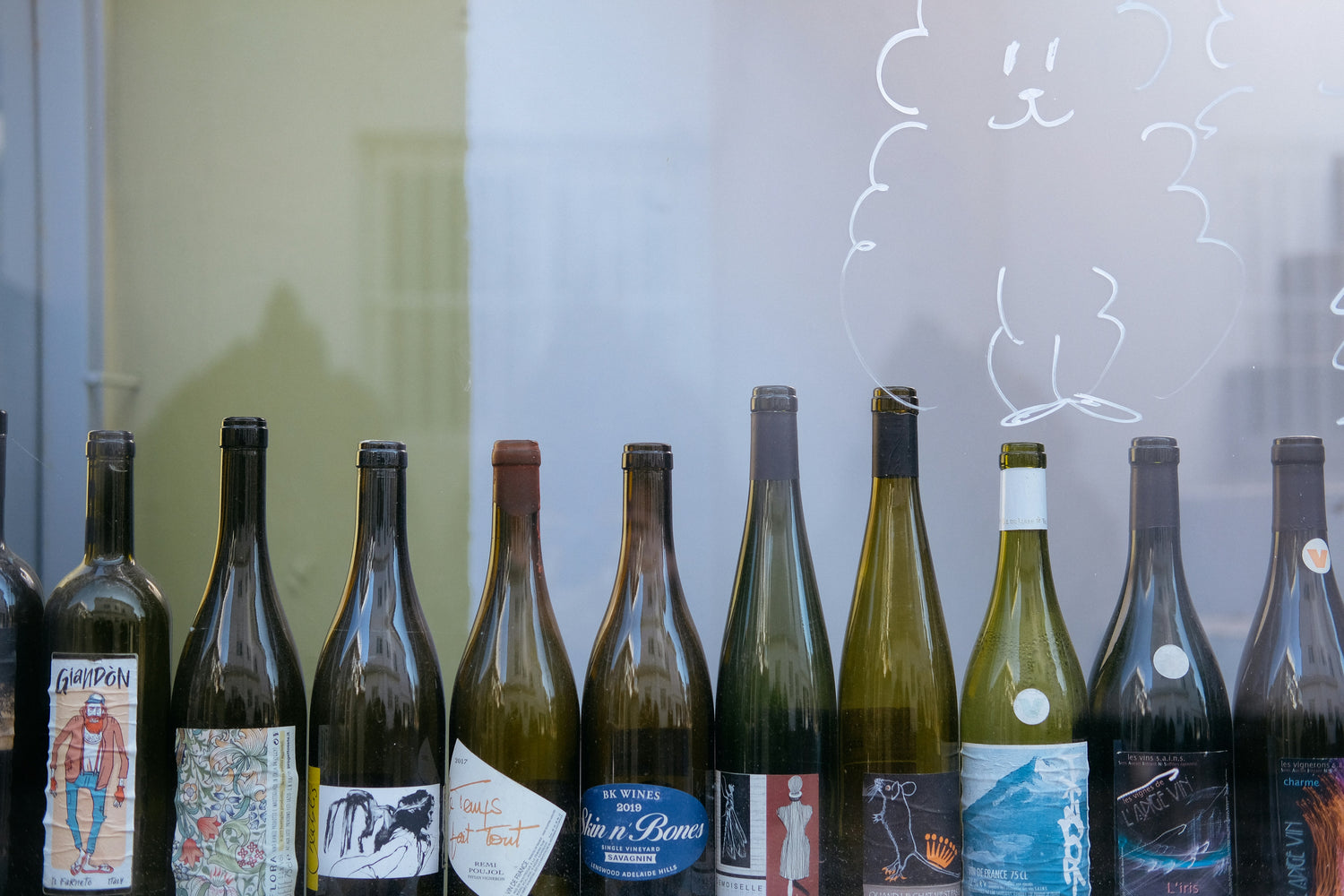
What is Natural Wine? 7 Things You Need to Know Before Your First Sip
gregory Kinsman-ChauvetShare
What is Natural Wine? 7 Things You Need to Know Before Your First Sip

Conventional wines can contain up to 350 parts per million of sulfites. Natural wine is different, with only 10 to 35 parts per million of minimal sulfites, which creates a unique wine experience.
More people have been asking " What is natural wine?" lately, and the answer remains beautifully simple. Natural wine exists as fermented grape juice—nothing more, nothing less. Wine producers still use the same low-intervention winemaking methods from 6,000 years ago. They handpick grapes grown without pesticides or herbicides, embracing organic farming practices.
Let me share natural wine's fascinating story. This piece explores natural wine's distinction from organic and conventional wines. You'll discover why natural wine's cloudy appearance and unique characteristics make it stand out. Natural wine's unique qualities will intrigue newcomers and curious wine enthusiasts who want to understand their glass's contents better, whether it's a classic red, a trendy orange wine, or a lively pet nat (short for pétillant naturel, a naturally sparkling wine).
The Story of Natural Wine: Old Ways Made New Again
"The true purpose of winemaking, its beginning and end, is to make wine naturally, following the process by which nature itself transforms grape juice into wine" — Ilia Chavchavadze, Prominent Georgian poet and politician
Archeologists make fascinating discoveries at ancient sites - traces of the world's first wines! The oldest evidence of winemaking dates back to around 6000 BCE in Georgia, a small European and Asian country [1]. This incredible history spans 8,000 years!
Ancient winemaking from 6,000 years ago
Ancient people made their first wines with remarkable simplicity. They crush grapes by foot and let the juice ferment naturally with indigenous yeasts. Clay pots, called amphorae, served as storage containers [2]. These early winemakers created pure, additive-free wine because modern chemicals didn't exist yet! This ancient method of amphora wine production is experiencing a revival among natural wine producers today.
Archeological discoveries in Georgia revealed pottery jars with wine residue dating back to 6000 BCE [3]. These pioneering winemakers created natural wine without even trying - they followed the only method they knew, relying on spontaneous fermentation and the vineyard's natural yeast.
"The fact that winemaking was already so well developed in 4000 BC suggests that the technology probably goes back much earlier," says researcher Patrick McGovern [4].
Wine captivated many ancient civilizations. The Greeks and Romans cherished it so deeply that they created wine gods—Dionysus and Bacchus, respectively [4]. Wine meant more than just a beverage to them. It became central to their religious ceremonies and daily routines.
How modern wine got so different
World War II marked a turning point in winemaking. Traditional methods passed down through generations dominated wine production before the war. Chemical pesticides and synthetic products transformed farming practices afterward [5].
On top of that, modern winemaking brought dramatic changes through:
-
Temperature-controlled fermentation tanks
-
Commercial yeasts instead of indigenous yeasts
-
Chemical additives to control flavor and color
-
Machinery for efficient processing
-
Filtration systems to make wine clear
"Before the advent of technology and modern winemaking techniques, all wine was essentially natural," notes wine historian Jane Smith [6].
A group of French winemakers in Beaujolais sparked the natural wine movement in the 1960s. People called them "The Gang of Four" [5]. These pioneers rejected chemicals and embraced their grandparents' traditional methods, focusing on sustainable production and minimal winemaking intervention.
Jules Chauvet, known as the godfather of natural wine, believed post-WWII insecticides and commercial yeasts damaged wine quality [5]. He championed a return to traditional winemaking principles, emphasizing the importance of terroir and natural fermentation processes.
Modern winemakers increasingly draw inspiration from ancient practices. They skip chemicals and trust nature's process, much like those first winemakers thousands of years ago, allowing the natural occurring microbiology to shape the wine's character.
Natural wine creates a direct link between ancient Georgian practices and today's global vineyards. The next section explores how these wines differ in taste and appearance from conventional modern wines.
What Is Natural Wine and Why Is It Special?
Natural wine is shaking up the wine world right now. What makes it so different? Let's pop the cork on this fascinating topic and explore the natural wine benefits.
The simple meaning of natural wine
Natural wine is wine at its purest—fermented grape juice with nothing added or removed [7]. Mass-produced wines use synthetic pesticides and undergo heavy processing, but natural wines skip all that [7]. This approach to low-intervention winemaking results in a product that's often referred to as "living wine" due to its vibrant, evolving character.
"Natural wine stands for several things important to the cosmopolitan/hipster elite: authenticity, uniqueness, craftmanship, durability, pure nature product, not as bad for the environment," notes one wine enthusiast [8].
Here's a simple way to look at it: When you squeeze orange juice at home without sugar or preservatives, you get natural juice. Natural wine works the same way - grapes do their thing!

Natural winemakers let fermentation happen with indigenous yeasts that live on grape skins and float around in the vineyard air [9]. This sets them apart from regular winemakers who add commercial yeast packets. The use of ambient yeast contributes to the wine's unique flavor profile and true representation of terroir.
How it's different from regular wine
Regular wines can have up to 49 additives in the European Union and 70 or more in the USA [7]. These additives change the wine's taste, appearance, and shelf life.
Natural wine keeps things simple! Here's what sets it apart:
-
Only organically grown grapes
-
Indigenous yeasts instead of commercial ones
-
Minimal or no added sulfites (10-35 parts per million vs 350 ppm in regular wines) [5]
-
Often unfiltered wine, giving it a cloudy look
-
Hand-picked grapes instead of machine harvesting [9]
-
No additives or commercial interventions
"Conventional wine is a grape product, plus all these millions of additives to create a product that is reliably the same every year," explains one wine expert [10].

Why people are talking about it
Young wine drinkers can't get enough of natural wine. What started as pushback against industrial wine practices [11] has become much bigger, focusing on sustainable production and organic practices.
Natural wine draws people in because it feels more real. "Natural wines taste livelier and are more true to where they are from," say natural wine supporters [9].
Natural wine's popularity stems from several factors:
The wine world has shifted toward green practices that protect soil and water [12]. Natural wine has made wine more approachable for young people - something wine professionals couldn't do for two decades [8].
"Natural wines have given the chance to taste new and weird things," says one wine lover [8]. Each bottle brings something new, unlike regular wines that taste the same year after year. This diversity includes styles like skin contact wine, also known as orange wine, which offers a unique tasting experience.
![Natural wine tasting event with young enthusiasts]
Natural wine isn't the same as organic wine. Organic certification only covers grape growing - not what happens during winemaking [9]. One expert puts it simply: "All natural wines are organic, but not all organic wines are considered natural" [13].
Regular wines try to taste the same every time. Natural wines celebrate being different. Every bottle tells its own story about where it's from, what grapes were used, and who made it - with no artificial ingredients getting in the way.
What Makes a Wine Truly 'Natural'?
"Whether or not it is certified (or indeed certifiable), natural wine does exist. It is wine from Vineyards that are farmed organically, at the very least, and which is produced without adding or removing anything during vinification, apart from a dash of sulfites at most at bottling" — Isabelle Legeron, Master of Wine and author of 'Natural Wine: An Introduction to Organic and Biodynamic Wines Made Naturally'
The natural winemaking process follows three main rules that create truly "natural" wines. Let's tuck into what makes these wines special.
No chemicals in the vineyard
Natural wine begins with healthy grapes. Natural winemakers rely on organic or biodynamic farming methods that enhance soil health and plant diversity [14]. These practices contribute to the wine's terroir, allowing the unique characteristics of the vineyard environment to shine through in the final product.
"If we make excellent vineyard decisions, we can make very few touches in the winery because we have beautiful and healthy fruit to work with," explains Paul Sloan, a natural winemaker [14].
Natural vineyards strictly avoid:
-
Synthetic pesticides
-
Chemical herbicides
-
Artificial fertilisers [15]
Natural vineyards also use animals, special plants, and moon cycles to help their grapes grow strong and healthy [16]. This holistic approach to viticulture is a cornerstone of biodynamic wine production.

Nothing added, nothing removed.
Natural winemakers follow a simple rule when grapes reach the winery - they keep their hands off, embracing a philosophy of minimal winemaking intervention.
"As with any natural product, the term natural wine simply indicates that nothing artificial has been added to the grape growing or winemaking processes," according to Food & Wine magazine [5].
Regular wines in the USA can contain up to 70 additives [5]. Natural wines skip these artificial ingredients altogether, relying instead on the grapes' natural qualities and the winemaker's skill to create complex flavors.
Natural winemakers stay away from:
-
Coloring agents
-
Fake oak flavour
-
Added sugar
-
Fining agents (to make wine clear) [15]
Your glass might look cloudy because many natural wines aren't filtered [5]. This unfiltered wine retains more of its natural character and complexity.
![Cloudy unfiltered natural wine compared to clear filtered conventional wine]
The importance of wild yeast
The sort of thing I love about natural wine is its use of indigenous yeast.
Each grape carries over 50,000 natural yeast particles [6]. These tiny wild creatures thrive on grape skins and float through vineyard air, contributing to the wine's unique flavour.
"Wild yeast fermentation is not the lazy way. Making good wine with wild yeast takes greater care and attention than inoculated fermentation," notes one winemaking expert [17].
Indigenous yeast creates more interesting wine flavors. Each vineyard's unique yeast "fingerprint" makes every natural wine distinct [6]. This spontaneous yeast fermentation is a key aspect of low-intervention winemaking.
Natural winemakers let nature handle fermentation like their counterparts did 8,000 years ago, while most modern wineries add commercial yeast [18]. This reliance on the vineyard's natural yeast strains contributes to the wine's authentic expression of its origin.
![Close-up of grape skins showing natural yeasts]
Natural wine stands apart from organic wine. Organic certification only covers grape-growing methods. Natural wine combines organic grapes with wild yeast fermentation and zero additives [5]. This means all natural wines qualify as organic, but organic wines don't always meet natural wine standards.
Natural Wine vs. Organic Wine: Not the Same Thing!
Ever noticed those "organic wine" bottles at the store? You might wonder if they're just like natural wines. Let me clear this up - they're pretty different!
The government sets strict rules for organic wine, but natural wine doesn't have any official rules [19]. They're like cousins—related but not twins.
Organic wine only has organic grapes.
The truth about organic wine lies in the grape-growing process. Farmers must grow these grapes without pesticides, herbicides, and chemical fertilizers [20].
"Legally speaking, organic wine must comply with the European Organic or French AB labels and be officially certified by an independent body," explains one wine expert [20].
Each bottle carries unique labels. French bottles show "AB" (Agriculture Biologique), while other regions use their own organic symbols [20].
The surprising part? Winemakers can add ingredients to organic wine after harvest. European producers can use up to 50 different additives [4]. This sets organic wine apart from natural wine!
![Organic wine certification label]
Some bottles say "made with organically grown grapes." This label means just 70% of the grapes meet organic standards [3]. The remaining grapes might not be organic at all!
"If a wine is labeled as being made with organic grapes, that means the grapes were organically grown, but the wine making wasn't necessarily organic," says a wine expert [21].
Organic winemakers have permission to use:
-
Added yeasts (instead of indigenous yeasts)
-
Egg whites and other animal products
-
Various flavor enhancers
-
Sulfites (in Europe and Canada) [22]
![Comparison of organic vs natural winemaking process]
One expert puts it perfectly: "While all natural wines are organic, not all organic wines are natural" [23]. Natural winemakers stick to organic or biodynamic grapes AND avoid adding or removing anything [24].
Picture it this way: organic wine follows a coloring book's rules. Natural wine uses only Mother Nature's tools!
![Organic vs natural wine ingredients comparison chart]
Farmers must follow organic methods for three whole years to earn their certification [25]. This shows their steadfast dedication!
Natural wine takes the "nothing added, nothing removed" approach, while organic wine focuses on grape-growing methods.
Natural Wine vs. Regular Wine: Spot the Differences
The differences between natural and regular wine are striking! Let's discover what makes natural wine unique and special.
Look differences: cloudiness and color
Natural wines are cloudy because they aren't filtered [2]. This cloudiness adds character to the wine's personality and is a hallmark of unfiltered wine.
"By contrast, natural wine is often unfiltered, which results in bottles with sediment and cloudiness," notes Serious Eats [2].
These wines showcase vibrant and unexpected colors. Deep, inky reds and golden-hued whites catch your eye [26]. Natural winemakers skip the dyes [2], so the grape's true colors shine through!
![Natural wine's cloudy appearance compared to filtered conventional wine]
Taste differences: lively and unique
The flavors dance on your tongue! Some bottles surprise you with tiny bubbles that remind you of fizzy soda, even though they're not meant to be sparkling [2]. This is especially true for pet nat wines, which undergo a single, natural fermentation in the bottle.
"Natural wine is alive—like kombucha and sauerkraut," explains one expert [2]. This living wine quality contributes to its complex flavors and evolving character.
Natural acidity gives these wines an electric feel in your mouth [26]. You might catch earthy notes, nutty flavors, or hints that remind you of a farm [27]. These unique flavor profiles are a direct result of low-intervention winemaking and the use of indigenous yeast.
The wine's character beautifully reflects its origins. One enthusiast shares, "Natural wines taste livelier and are more true to where they are from" [28]. This authentic expression of terroir is a key benefit of natural wines.
Label differences: what to look for
Regional designations often don't appear on natural wine labels because they're deemed "atypical" [1]. Watch for these terms:
-
Vin de France (France)
-
Vino di Tavola (Italy)
-
Wein aus Österreich (Austria)
"Many natural wines are prohibited from stating the regional designation," explains Wine Enthusiast [1].
A unique label called "Vin Méthode Nature" helps identify authentic natural wines in France [1].
![Natural wine label example with minimal information]
Serving temperature tips
Natural red wines taste best slightly cooler than conventional ones - around 15-16°C [29]. White varieties shine at 10-12°C [29]. These serving temperatures help showcase the wine's natural characteristics and complex flavors.
Light, juicy natural reds such as Gamay or Frappato deserve a quick chill. "Throw them in the refrigerator for 20 minutes or so before decanting," suggests one expert [30].
Food pairings that work well
Natural wines make food taste amazing, thanks to their mineral content, saltiness, and savory qualities [31]. These characteristics, derived from organic farming practices and minimal sulfites, create versatile pairing options.
These combinations never fail:
-
Salted chips with Cati Ribot Cambuix from Mallorca
-
Fish and chips with Tissot Crémant de Jura
-
Strawberry desserts with L'Archetipo Susumante pét-nat [31]
"Natural wine has an almost guaranteed undertone of acidity, which keeps the tongue and mind alert throughout a meal," explains one sommelier [31].
![Natural wine paired with casual food like fish and chips]
What to tell your friends about it
Your friends should know that patience pays off with natural wine. "Some natural wines need to be opened several hours before they are served," suggests wine expert Pierre Jancou [27]. This allows the wine to breathe and fully express its unique characteristics.
Natural wine resembles fresh-squeezed juice - pure and unprocessed. Regular wines can contain up to 70 additives [27], while natural wine lets grapes express themselves through spontaneous fermentation and minimal winemaking intervention.
The uniqueness of each bottle adds to the excitement. Encourage your friends to embrace the adventure and explore the diverse world of natural wines, from classic styles to more experimental offerings like orange wine and pet nat!
Conclusion
Natural wine stands out with its remarkable simplicity. The process mirrors how people made wine 8,000 years ago - pure grape juice transforms into wine naturally. This authentic approach resembles the difference between fresh-squeezed orange juice and processed store varieties.
The term "organic wine" only indicates that grapes were grown without chemicals. However, winemakers can still add up to 70 different substances to organic grapes after harvest. Natural wine takes a purist approach—nothing added, nothing removed.
Each natural wine bottle captures the true essence of its origin. The cloudy appearance and distinct flavors make these wines unique. Every bottle tells its story through authentic characteristics, whether traditional red, a trendy orange wine, or a lively pet nat.
Natural wine deserves an open mind because it represents wine in its purest form. Wine enthusiasts and newcomers alike will find something exciting to explore in each bottle. This is wine precisely as nature intended, showcasing the beauty of low intervention winemaking and the complex flavors that arise from indigenous yeast and organic farming practices.
FAQs
Q1. How can I identify natural wine? Look for phrases like "minimal intervention," "natural winemaking techniques," or "unfined/unfiltered" on the label. Natural wines often have minimal information on the label and may use terms like "Vin de France" or "Vino di Tavola." Some regions have specific labels like "Vin Méthode Nature" in France to indicate natural wines. Look for terms like "pet nat" or "skin contact wine", which often indicate natural winemaking methods.
Q2. What are the main differences between natural and conventional wines? Natural wines are made with minimal intervention, using only organically grown grapes and indigenous yeasts for fermentation. They contain little to no added sulfites and are often unfiltered, resulting in a cloudy appearance. Conventional wines, on the other hand, may use various additives and technological processes to ensure consistency in taste and appearance. Natural wines often have more unique flavor profiles and a true representation of terroir.
Q3. Where can I find natural wines? The best way to find natural wines is to ask your local wine store or follow wine shops and restaurants on social media. Many specialty wine stores and trendy restaurants now carry natural wines. You can also look for wine bars specialising in natural wines or attend natural wine fairs and tastings. Online retailers focusing on low intervention wines are also becoming more common.
Q4. Are natural wines lower in alcohol content? Generally, natural wines tend to have lower alcohol content than conventional wines, often ranging between 10-13% ABV. This lower alcohol content may explain why some people report feeling less affected after drinking natural wines. However, this can vary depending on the grape variety and winemaking style.
Q5. How should I serve and pair natural wines? Serve natural red wines slightly cooler than conventional reds, around 15-16°C, and whites at about 10-12°C. Natural wines pair well with various foods due to their mineral and savory qualities. They're particularly good with casual fare like fish and chips or salted snacks. Remember to open the bottle a few hours before serving to allow the wine to breathe and fully express its unique characteristics. Experiment with styles like orange wine or Pet Nat to find exciting new pairings!
References
[1] - https://www.wineenthusiast.com/culture/natural-wine-labels/?srsltid=AfmBOor5euvg2ES_CNAQYbLSAmMPSiozPtjE00kg6Mgx8klNwVU_Tqec [2] - https://www.seriouseats.com/what-is-natural-wine-8610989 [3] - https://davidsuzuki.org/living-green/organic-wine-explained/ [4] - https://www.bibendum-wine.co.uk/training-hub/organic-wine-mindfulness-and-misconceptions/ [5] - https://www.foodandwine.com/wine/what-is-natural-wine [6] - https://pullthecork.co.uk/wild-fermentation-embracing-individuality-in-the-wine-world/ [7] - https://www.healthline.com/health-news/health-benefits-natural-wine [8] - https://www.reddit.com/r/wine/comments/1evijr4/why_are_natural_wines_become_so_popular_these_days/ [9] - https://www.dryfarmwines.com/blogs/a-matter-of-taste/natural-wine-vs-regular-wine?srsltid=AfmBOop60bZmaEEICsd6DchPoHbGpZDNgaIT_y9663y8Vy1zBGPk15Ee [10] - https://www.vox.com/the-goods/2019/6/10/18650601/natural-wine-sulfites-organic [11] - https://wyrd-wine.com/blogs/blog/from-conventional-to-natural-wine?srsltid=AfmBOopUlBu62nQwsvn5M4CUkGO-F_sih9bCgbHjfmU9e4NskfH5kquJ [12] - https://morenaturalwine.co.uk/blogs/natural-wine/the-health-benefits-of-natural-wine [13] - https://theearthwine.com/blogs/natural-wine-journal/is-natural-wine-better-for-your-health-an-in-depth-look?srsltid=AfmBOop0-tSDZWk1SNrqvlyPKfhy9v7q5rVFex-IQQmScE6w2BvDohLk [14] - https://www.decanter.com/learn/what-does-minimal-intervention-really-mean-530111/ [15] - https://vindesoif.co.uk/2025/02/27/discover-the-secrets-behind-natural-wine-production/ [16] - https://thewinecaverns.co.uk/blogs/news/exploring-eco-friendly-sustainable-wine-practices?srsltid=AfmBOoqmkJjlFkAxR288bLgyjZstkV8fN7pGkWD

